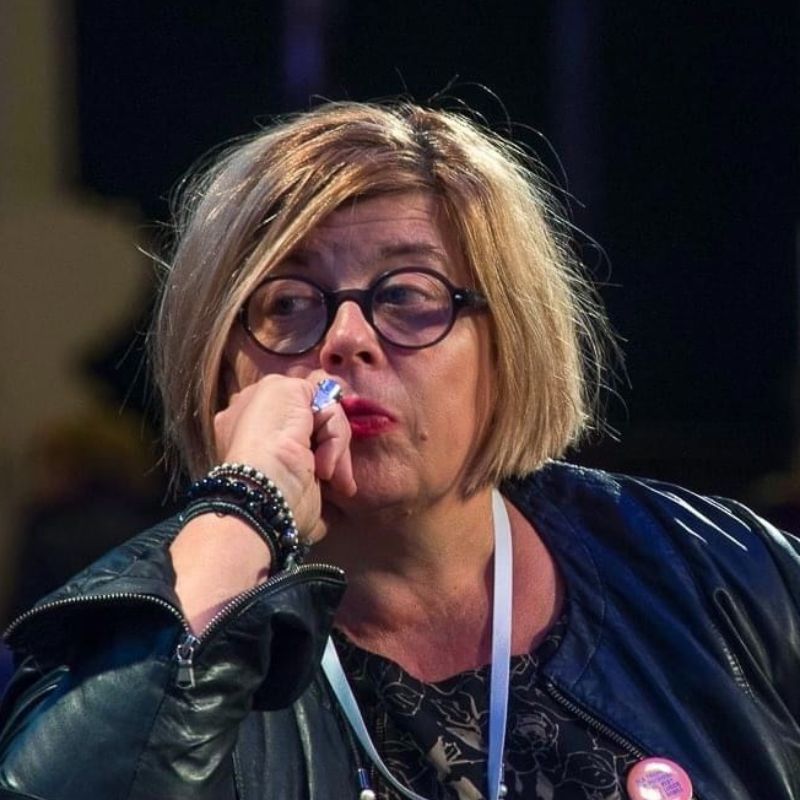Beata Chmiel is the co-founder and executive president of the Women of Film Association, which aims to promote equal opportunities and gender equality in the Polish audiovisual industry. In 2010, she was one of the initiators of the Citizens of Culture initiative, which advocates for a more citizen-centered approach to media and cultural policy. She also co-initiated the Citizens’ Pact for Public Media, which was signed by more than 100 civil society organizations in 2016 and campaigns for a more independent and inclusive public media in Poland.
What are the main challenges for Polish Public Service Media at the moment?
We urgently need to reform the public media in Poland – but reform it through revolution. Since 2016, when the ruling national-conservative party turned them into a propaganda tool, resulting in a decline in public trust in information and rational public debate, the no longer public media have deepened social divisions and threatened democracy. Now, we need to reclaim them in a constitutional and modern form, catering to the needs and habits of audiences beyond traditional radio and TV. It’s a critical mission that demands our immediate attention. The changes in the Polish electoral landscape after October 15th last year can significantly legitimize responsible organizational reform. It is necessary to develop a new strategy beyond competitive politics. Politicians, journalists, experts, and legislators must once again return to the round table and redesign media for the digital age that strengthens the public sphere, diversity of representation, social cohesion, and active civil society; that provides reliable information, promotes media education and civic education, that creates the conditions for artistic expression, and that expands opportunities for participation in culture and public life. It’s a unique opportunity for a transformative change of PSM to adapt to social and technological challenges, AI, and ubiquitous algorithms. To protect the public mission of the media as a trusted source of information and a responsible moderator of user-generated content, we need to implement actual citizen control, changes in organizational culture, new technologies, as well as transparent and sustainable funding.
Could you tell us about your projects and activities related to it?
I stood as one of the initiators and leaders of the initiative Citizens of Culture in 2010 and a signatory of the Pact for Culture setting out state obligations in the field of culture and cultural education. Citizens of Culture and the Citizens’ Committee for Public Media prepared and submitted a draft law on the media after public consultations on public media, based on a return to the idea of media serving citizens. Unfortunately, the project has not been subject to further legislative work, which would have protected the public media from its partisanship after the national-conservative coalition took power in 2015. The Citizens’ Pact for Public Media that we initiated in 2016 formulated five conditions for a modern law on public media, without which it is impossible to guarantee program quality and ensure its impartiality, credibility, and reliability. The pact demanded a legal requirement for programme licences that would set a percentage of the PSM’s total budget to be spent on programmes for children and young people and on contemporary audiovisual creativity, and to establish a public fund to co-finance the production and distribution of high-quality programmes and content that fulfil public service objectives by non-public and commercial audiovisual and digital media.
How would you expect the situation of Polish Public Service Media to develop in the near future?
For 15 years, we as citizens have been saying that public media must be independent of party politics and propaganda with different views and visions of the world clashing, so it must be a guarantor and a place for the realization of human and civil rights enshrined in the Constitution – including the right to reliable and credible information and the right to equal access to culture and education. PSM must be a reliable system of socially relevant communication not only in the event of a natural disaster or epidemic and its credibility also depends on how its boards are appointed through an open public procedure and based on a transparent system of recommendations from NGOs and industry guilds. Therefore, a completely different media model is needed, one that invests in innovative formats and new technologies. A media through which young people from the next generation of the small screen, but this time already of the smartphone, will learn to perceive and create public journalism as an attractive and viable environment for information, communication, collaboration, and participation.
Which topics affecting Public Service Media do you feel will require the most involvement of both practitioners and researchers?
Public media are socially indispensable, but the question remains whether their current organization offers a chance to develop in the new media environment. A fourth industrial revolution is coming, and as a result, new forms of machine-based communication will soon subdue the media market. It is not a question of expanding into digital media, VOD, or social media, which public media in Poland are coping with in different ways. The internet and its associated social media platforms serve only as channels for content promotion. Although binge, stream, transmedia, or internet of things are no longer unfamiliar terms, all parties involved in the debate about the future of PSM act as if the public still uses only linear radio and television, and that the unattainable prototype is the BBC model of the 20th century. Arguments about the role of algorithms, virtual reality, smart cities, or the role of media in creating high-tech clusters are seen as something out of a science fiction movie script. According to Ericsson’s research, 75 per cent of all video activity took place on mobile networks last year, but how the representatives of the “glass generation” use the media seems to be of little interest to researchers and practitioners in the Polish discussion. And that is the biggest challenge.

